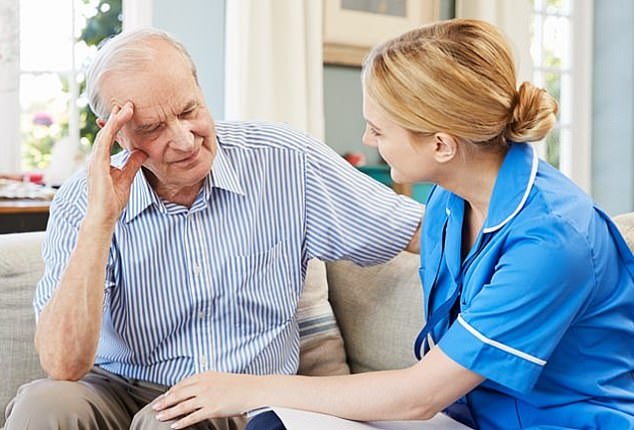Listening to music and playing instruments helps stroke patients recover by ‘stimulating their brain and lifting their mood’
- Study carried out at 26-bed stroke and rehab unit at Addenbrooke’s hospital
- Musical instruments helped by improving finger dexterity and cognitive training
- The mood of the patients was lifted generally, helping them to concentrate
- Researchers found repetition was central to the rehabilitation of the patients
Listening to music helps stroke patients recover by stimulating their brain and lifting their mood, a study suggests.
In the first study of its kind, researchers evaluated how music therapy improved the lives of stroke patients in Cambridge.
Stroke is a leading cause of disability in the UK, causing motor skill problems and leaving sufferers struggling to cope mentally among many things.
The study found playing the keyboards, drums and percussion instruments, as well as using iPads, lifted patients’ general mood and helped them concentrate.
The sessions also helped with hand rehabilitation by improving finger dexterity, the researchers found. Repetition was key to helping patients recover.

The study was led by Dr Alex Street, of Anglia Ruskin University (ARU), and was carried out on a 26-bed stroke and rehabilitation unit at Addenbrooke’s hospital in Cambridge
Strokes, a leading cause of death and disability in the UK, have devastating effects on sufferers long term, rendering many people inept at simple tasks.
As well as speech and language problems, sufferers struggle with their memory, visio-perceptual skill and even personality changes among other things.
The effects can also have a huge mental impact on patients, feelings of anger, anxiety or depression are common after a stroke.
The study was led by Dr Alex Street, of Anglia Ruskin University (ARU), and was carried out on a 26-bed stroke and rehabilitation unit at Addenbrooke’s hospital in Cambridge.
Neurologic Music Therapy (NMT) sessions were run alongside existing stroke rehabilitation treatment of physiotherapy, occupational therapy, speech therapy and clinical psychology.
A total of 177 patients took part in 675 NMT sessions over two years, according to the findings published in the journal Topics in Stroke Rehabilitation.
NMT proved ‘helpful’ or ‘very helpful’ on average for 139 patients, relatives and hospital staff.
Of the 52 patients who completed mood scale questionnaires, there was a reduction in ‘sad’ and an increase in ‘happy’ responses immediately following a session.
Speech and language therapists observed a positive impact on patient arousal and engagement.
They also reported NMT may help patients overcome low mood and fatigue – both common following stroke – and therefore be beneficial in their rehabilitation.
Dr Street said: ‘Our study found that Neurologic Music Therapy was received enthusiastically by patients, their relatives, and staff.
‘The fact 675 sessions were carried out in two years is in itself an indication of the success of the treatment.
‘It shows that staff are referring patients because they understand the mechanisms of the exercises and can see how it can benefit their patients.
‘It also shows that patients are willing to do the exercises, with each one participating in an average of five sessions.’
‘Staff felt that using music and instruments allowed patients to achieve a high amount of repetition to help achieve their goals.
‘They felt that the exercises appear less clinical, because the patients are playing music with the music therapist, and they are receiving immediate feedback from the exercises, through the sounds they create.’
Leading charity Stroke Association welcomed the research which showed music can help people rebuild their lives after a stroke.
Dr Richard Francis, head of research, said: ‘These latest findings indicate that individuals find music therapy helpful and it can play an important role in their recovery.
‘However, it is worth noting that the study took place in a single hospital and so more evidence is needed to demonstrate the benefits of music therapy.
‘We’re here to support everyone affected by stroke and fund vital stroke research, including how singing can help stroke survivors with aphasia (a communication disability).’
Dr Street added: ‘Further research is necessary to establish potential effects of music therapy on recovery rate and length of hospital stay.’
Following the success of the trial, the Cambridge Institute of Music Therapy Research at Anglia Ruskin University (ARU) and Addenbrooke’s Hospital are developing a proposal to establish a permanent NHS-funded NMT post on the stroke ward.
